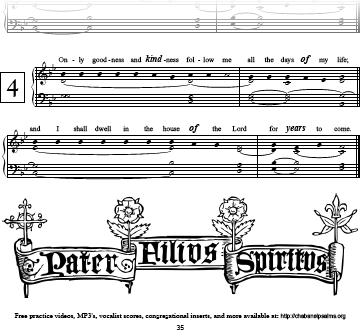The Chabanel Tones (PSALM TONES)
-
Feel Free to browse through all 180 pages of THIS PROJECT.
Some of you might be particularly interested in the CHABANEL PSALM TONES.
click here to see the Chabanel Tones

Click Here to Learn More. -
Jeff,
Thank you for this great resource! I believe you based these tones off of the Gregorian modes. Do you indicate anywhere which of the Chabanel Tones correspond to which mode? -
Dan, THANKS!
Believe it or not, I have not done this.
I find those tones to be "flexible" with regard to mode. Some people might raise an eyebrow, but I'm sure you're familiar with the fact that modes were originally reckoned by the FIRST note of the chant, then, over time, it changed to the LAST note. The whole purpose is to get back and forth from the Antiphon without a problem, and as long as this works, I'm happy (I'm a simple person, after all). -
Great work! These tones work well with English accent and an untrained congregation could easily sing these from a pointed text.
Because there is no official music for the English antiphons: I have found a greater practical need for a contrasting antiphon formula rather than a verse formula tone when preparing scores in English.
I still enjoy the challenge of trying to create a supple English accent in the correct location with the traditional psalm tones. The traditional psalm tones demand a lot of custom tailoring to judiciously fit into English texts. When done well, the traditional chants transform English into a different energy just a rhyme and meter transform our vernacular into poetry. I still like the effect the chants have on English. Its worth the pursuit. -
JO
We sing your setting of Psalm 23 often... I really like that tone.
Thanks for your great work.
fk
Welcome to the MusicaSacra Forum!
To participate in the discussions on Catholic church music, sign in or register as a forum member, The forum is a project of the Church Music Association of America.
Categories
- All Discussions21,059
- General Music Discussion8,196
- Job Openings191
- Management of Music Programs850
- Choral Matters532
- Church Documents and Rubrics524
- CMAA Notes300
- Events712
- For Newcomers: Read First26
- Sacred Polyphony546
- Hymnody871
- Gregorian Chant: General2,694
- ↳ Graduale Romanum and Liber Usualis367
- ↳ Graduale Simplex60
- ↳ Semiology63
- Vernacular Plainsong695
- Anglican Use and Anglican Chant69
- Organ, Other Instruments and Repertoire434
- New Composition/Works in Progress1,287
- Recordings229
- Music for Hispanic Ministry159
- Music Education: Children211
- Music Education: General222
- News Items245
- Positions Wanted2
- General Discussion: Catholicism738
- Amusements176
- General Discussion1,033
- Opinions117



